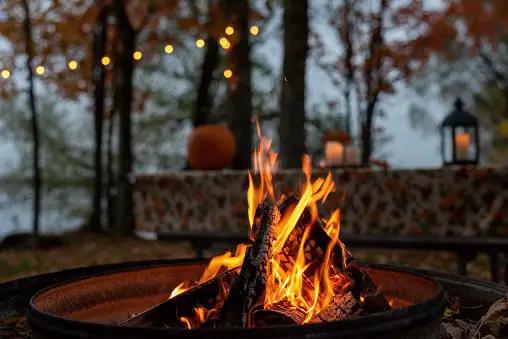Fire pits are fantastic features to place on your concrete patio where you can host guests, enjoy the outdoors on a chilly evening, or just have a relaxing hang out spot. While many people enjoy the warmth and ambience fire pits provide, it’s important to consider how they could affect the concrete beneath them, and whether this could be prevented.
Fire pits can potentially damage concrete over time. The high heat they exude can cause spalling and scorching, and heavier pits can cause the material underneath to crack. However, concrete damage from a fire pit is not definite.
If you’re considering installing a new fire pit, read on as we discuss how these aesthetic and social pieces could cause undesirable damage to any concrete slab or patio underneath. We’ll also provide tips for preventing this damage, so you don’t have to spend more on concrete repairs or place your fire pit in an alternative, less than ideal, location.
How Do Fire Pits Damage Concrete?
Concrete is a favored foundation for fire pits, as they don’t pose a fire hazard (like lawn grass) and provide a sturdy base to keep your fire pit stable at all times.
Unfortunately, while it might be appealing to turn that barren concrete slab into a gathering place with your fire pit as the central focal point, it’s important to recognize that a well-used fire pit will likely damage any material underneath, including concrete.
High Heat Temperatures
The leading cause of concrete damage by fire pits is the excessive heat radiating from them while in use. A metal fire pit can reach temperatures up to 800°F, and 200° to 400° of radiant heat beneath it. Over time, this will dehydrate the concrete and lead to spalling, scorching, and cracking.
While this heat alone is enough to cause significant concrete damage over time, it isn’t the only factor at play.
Heavy
Fire pits can also be incredibly heavy pieces weighing anywhere from 20 pounds to over 200 pounds without factoring in the extra weight of wood. The constant pressure of this weight on any concrete slab or patio can also cause the material to crack, especially if the foundation underneath the concrete isn’t strong or stable enough to support both the concrete and the fire pit on top of it.
Frequency of Use
The last factor that affects how much a fire pit could damage concrete is frequency of use.
Unsurprisingly, the more you use your fire pit, the more often you’re exposing the concrete below to its high heat, which expedites potential cracking. This goes for session length as well (ex. you might only use it a few times a year, but if you’re fueling a fire all day, you’re more likely to scorch concrete underneath and cause further damage).
How to Protect Your Concrete From Fire Pit Damage
Damaging the concrete underneath your fire pit is a very real concern, but luckily, this damage isn’t definite. There are several preventative measures owners can take to ensure their concrete and fire pit stay in optimal condition and they don’t have to be faced with the decision of living with damaged concrete or spending extra money to repair it.
How you protect your concrete from fire pit-related damage depends on the type of fire pit you have (ex. above ground versus in-ground).
Damage caused by an above ground fire pit can be prevented easily by installing a barrier between its underside and the concrete’s surface, whereas in-ground fire pits will require more extensive preventative measures, such as construction with fire bricks or concrete pavers on top of the concrete.
Use a Protective Barrier
Above ground or elevated fire pits are by far the most popular and less likely to cause severe damage to nearby concrete because there is additional space between the bowl, where the majority of the heat radiates, and the surface below.
Still, you’ll want to place something between the fire pit and concrete to protect its surface, such as:
- Fire pad protector
- Ember mat
- Heat retardant mat
- A layer of fire resistant rocks
As or in-ground fire pits, you can have the concrete professionally treated or even have the concrete itself mixed with additives to help it become more resistant to high heat or protect the surface from potential damage.
Final Thoughts
Ultimately, when it comes to fire pits, concrete isn’t the best foundational material, as some degree of damage is nearly inevitable, and usually the concrete is replaced at one point or another. Therefore, if you are in the early stages of planning, you might want to opt for a material that is more resistant to high temperatures, like fire-rate brick or hard natural stones, such as granite, marble, or slate.
Otherwise, you’ll want to use the preventative measures listed above immediately and consistently.

